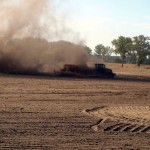
Efforts of the San Francisco Public Utilities Commission to gain control of water used by local farmers captured many recent newspaper headlines, but little attention has been given another insidious problem, the loss of farm land top soil.
Some dubious farming practices are a threat to the viability of farming in the San Joaquin Valley. Loss of essential top soil can be as damaging as the inability to secure an adequate water supply.
The loss of top soil is easy to see. When farmers plow their dry fields on windy days, large quantities of dust blow away. During the nut harvest, blowers raise large plumes of dust throughout the valley that blow into the cities, the foothills, and the upper atmosphere.
In the past 12 years, the soil in residential areas of Modesto has built up as much as 2 inches as a result of the frequent deposit of dust blown in from nearby farms. Since city residents keep plants watered and the soil wet, nearly all the soil is retained, building up over time.
The Magnitude of the Problem
Nearly one third of the farm land in the Central Valley is no longer arable due to excess concentrations of salt and acidic soil at the surface. When top soil is blown away, the soil becomes more difficult and less productive to farm. The remaining soil gradually degrades until nothing will grow.
If you want to see how land has changed because of dubious farming practices, take a drive on State Route 45 south of Wasco. Large swaths of land are no longer farmed. The barren soil has turned alkali white. Almost nothing grows there. This is in sharp contrast from the years before the land was first farmed, when water-filled wetlands produced dense vegetation and abundant wild life.
Air Pollution
The San Joaquin Air Pollution Control District is worried about PM-10, which is fine dust blown into the air from farms. The dust, which is also valuable top soil, is a form of air pollution. The air pollution is a major health concern, getting into lungs to aggravate asthma sufferers. One in six children living in the southern Central Valley has asthma, most likely as a result of inhaling air borne dust pollution. Valley Fever is also believed to originate in the top soil. The organism grows in the soil, the wind picks it up, and people inhale it.
Blowing dust, sometimes from farms, has caused multi-car accidents on Freeway 99 and Interstate 5 in the Central Valley, as well as on other area highways.
Considering the negative impacts of blowing dust, farmers should realize that the wisest practice is to keep the soil from blowing away. However, anyone who lives here during the nut harvest can see that the best farming practice is not being observed by a substantial percentage of growers.
The Government Solution
While government could legislate dust control, farmers would be wise to consider voluntarily changing some of their practices. Given the fact that farmers generally dislike government regulation, self-regulation may be wise before the government decides to intervene. Since the San Joaquin Valley has already missed its deadline to meet federal air pollution standards, time is growing short for farmers to voluntarily improve the way they manage their top soil.

corporate farms have been putting up signs along I5 blaming congress for the ‘dust bowl’
but congress is not out on a tractor plowing the top soil and spraying round-up!
very large farms need to be regulated we can not leave this up to the rules of corporate profit, land that will not be replanted should not be left ripped , nature will reclaim the land quickly if it’s not hosed down with weed killer, tracks that are not farmed for a few years should be recalled from the Williamson act ( a tax dodge ) and that will trigger a sale or redistribution , so smaller farmers can have a chance to farm it in a sustainable way
we must also fix this crap with the power grid that forces the farmers to run a dirty old diesel fuel engine just to pump water when a power line is on site….
we can all help just by shopping at the local farmers market and bypassing the thousand mile corporate food chain.
My understanding of the dust bowl problem mentioned in Mr. Johnson’s comment is that Congress determined water allocation in the law. The Central Valley water project is unable to deliver all the water needed to farm all the land that farmers wish to farm. The areas left dry constitute the dust bowl. The subject of water allocation is a topic not touched by this article.
Regarding soil conservation in farming practices, if a little water is applied to soil before it is plowed, it can be plowed with little dust being kicked up. For the Almond Harvest, plastic tarps could be laid over the ground before trees are shaken. This would protect the underlying top soil. In Italy, tarps are hung on tree branches to catch and collect falling nuts. The cost of farming is a little higher using methods that are a little more labor intensive. However, the value in preserving valuable topsoil more than makes up for the increased labor cost because the land will remain productive.